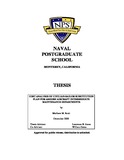Analysis of operational manning requirements and deployment procedures for unmanned surface vehicles aboard U.S. Navy ships
| dc.contributor.advisor | Hatch, Bill | |
| dc.contributor.advisor | Simon, Cary | |
| dc.contributor.author | Richter, Matthew P. | |
| dc.date.accessioned | 2012-03-14T17:35:44Z | |
| dc.date.available | 2012-03-14T17:35:44Z | |
| dc.date.issued | 2006-09 | |
| dc.identifier.uri | https://hdl.handle.net/10945/2616 | |
| dc.description.abstract | This research was conducted in association with Naval Warfare Development Command (NWDC) requests to update Unmanned Vehicle Tactical Memorandum TM-3-22- 5-SW. The research identified and discussed significant USV manning considerations such as source ratings and manpower qualities to pilot, operate sensors, support USV electronics, and the manpower implications associated with various weapons systems alternatives. In addition, this research described several existing and notional USV tactics, as well as a discussion about the existing N75 and N76 primary and secondary mission areas USV operations may support. The methodology consisted of a literature review of USV test reports; USV Advanced Concept Technology Demonstration briefs; USV Concept of Operations; fleet lessons learned; the USV tactical memorandum; Naval manpower instructions, and manuals; Weapons Tactical, Field, and Training Manuals; Military Utility Assessments; search of books, magazines, and manpower theses. The research found that determining manpower qualities and standard operating procedures will remain a dynamic process until USV equipment is standardized. The research also showed USV launch and recovery is more manpower intensive than that of a standard RHIB. Gunners Mates (GM) and Aviation Ordnancemen (AO) are potential source ratings to support USV Hellfire and Javelin missile modules. The Navy should establish a GM Navy Enlisted Classification (NEC) to support Hellfire and Javelin or add these weapons to existing GM NECs. Electronics Technicians (ET), Fire Controlmen (FC), and Fire Control Technicians (FT) are potential source ratings for USV electrical/electronic support. FC and FT are potential source ratings to support the Remote Operated Small Arms Mount. This research found additional warfighting capabilities can be gained by equipping surface warfare vessels with USV's without any negative effects to primary or secondary warfare missions. Overall, USVs enhanced designed capabilities of Naval warships and directly support a capabilities based Navy. | en_US |
| dc.description.uri | http://archive.org/details/analysisofoperat109452616 | |
| dc.format.extent | xviii, 74 p. : col. ill. ; | en_US |
| dc.publisher | Monterey, California. Naval Postgraduate School | en_US |
| dc.subject.lcsh | Manpower | en_US |
| dc.subject.lcsh | Weapons | en_US |
| dc.subject.lcsh | Electronics | en_US |
| dc.subject.lcsh | Ships | en_US |
| dc.subject.lcsh | Electronic technicians | en_US |
| dc.subject.lcsh | Naval battles | en_US |
| dc.subject.lcsh | Weapons systems | en_US |
| dc.title | Analysis of operational manning requirements and deployment procedures for unmanned surface vehicles aboard U.S. Navy ships | en_US |
| dc.title.alternative | Operational manning considerations for Spartan Scout and Sea Fox unmanned surface vehicles (USV) | en_US |
| dc.type | Thesis | en_US |
| dc.contributor.corporate | Naval Postgraduate School | |
| dc.contributor.school | Graduate School of Business and Public Policy (GSBPP) | |
| dc.identifier.oclc | 73523901 | |
| etd.thesisdegree.name | M.A. | en_US |
| etd.thesisdegree.level | Masters | en_US |
| etd.thesisdegree.discipline | Business Administration | en_US |
| etd.verified | no | en_US |
| dc.description.distributionstatement | Approved for public release; distribution is unlimited. |
Files in this item
This item appears in the following Collection(s)
-
1. Thesis and Dissertation Collection, all items
Publicly releasable NPS Theses, Dissertations, MBA Professional Reports, Joint Applied Projects, Systems Engineering Project Reports and other NPS degree-earning written works.





